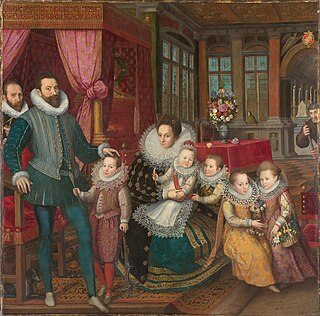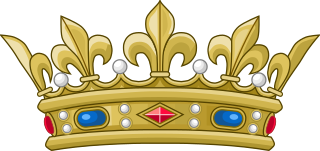A prince is a male ruler or member of a monarch's or former monarch's family. Prince is also a title of nobility, often hereditary, in some European states. The feminine equivalent is a princess. The English word derives, via the French word prince, from the Latin noun princeps, from primus (first) and capio, meaning "the chief, most distinguished, ruler, prince".
A duke (male) or duchess (female) can either be a monarch ranked below the emperor, king, and grand duke ruling over a duchy or a member of royalty or nobility, historically of highest rank, below princes of nobility and grand dukes. The title comes from French duc, itself from the Latin dux, 'leader', a term used in republican Rome to refer to a military commander without an official rank, and later coming to mean the leading military commander of a province.
Grand duke is a European hereditary title for either certain monarchs or members of certain monarchs' families. It is traditionally ranked in order of precedence below the title of emperor, king or archduke and above that of sovereign prince or sovereign duke. It is used in some current and former independent monarchies in Europe, particularly:
Fürst is a German word for a ruler and is also a princely title. Fürsten were, since the Middle Ages, members of the highest nobility who ruled over states of the Holy Roman Empire and later its former territories, below the ruling Kaiser (emperor) or König (king).
Royal Highness is a style used to address or refer to some members of royal families, usually princes or princesses. Monarchs and their consorts are usually styled Majesty. When used as a direct form of address, spoken or written, it takes the form "Your Royal Highness". When used as a third-person reference, it is gender-specific and, in plural, Their Royal Highnesses (TRH).
His/Her Serene Highness is a style used today by the reigning families of Liechtenstein, Monaco, and Thailand. Until 1918, it was also associated with the princely titles of members of some German ruling and mediatised dynasties and with a few princely but non-ruling families. It was also the form of address used for cadet members of the dynasties of France, Italy, Russia and Ernestine Saxony, under their monarchies. Additionally, the treatment was granted for some, but not all, princely yet non-reigning families of Bohemia, Hungary, Italy, Poland, Romania and Russia by emperors or popes. In a handful of rare cases, it was employed by non-royal rulers in viceregal or even republican contexts.
His or Her Grand Ducal Highness is a style of address used by the non-reigning members of some German ruling families headed by a Grand Duke. No currently reigning family employs the style, although it was used most recently by the younger sisters of the late Grand Duchess Charlotte of Luxembourg. Since Grand Duchess Charlotte's marriage to Prince Felix of Bourbon-Parma, all of their male-line descendants have used the style Royal Highness, which he bore.
Monseigneur is an honorific in the French language, abbreviated Mgr., Msgr. In English use it is a title before the name of a French prelate, a member of a royal family or other dignitary.
Majesty is an English word derived ultimately from the Latin maiestas, meaning greatness, and used as a style by many monarchs, usually Kings or Queens where used, the style outranks the style of (Imperial/Royal) Highness, but is inferior to the style of Imperial Majesty. It has cognates in many other languages, especially Indo-European languages of Europe.
Highness is a formal style used to address or refer to certain members of a reigning or formerly reigning dynasty. It is typically used with a possessive adjective: "His Highness", "Her Highness" (HH), "Their Highnesses", etc. Although often combined with other adjectives of honour indicating rank, such as "Imperial", "Royal" or "Serene", it may be used alone.
Imperial and Royal Highness is a style possessed by someone who either through birth or marriage holds two individual styles, Imperial Highness and Royal Highness. His/Her Imperial Highness is a style used by members of an imperial family to denote imperial – as opposed to royal – status to show that the holder is descended from an Emperor rather than a King. Holders of the style Imperial Highness generally rank above holders of the style Royal Highness.

Prince of the Holy Roman Empire was a title attributed to a hereditary ruler, nobleman or prelate recognised as such by the Holy Roman Emperor.
His/Her Illustrious Highness is the usual English-language translation for Erlaucht, a style historically attributed to certain members of the European aristocracy. It is not a literal translation, as the German word for "Highness" is Hoheit, a higher style that appertained to sovereign dukes and other royalty.
Prince étranger was a high, though somewhat ambiguous, rank at the French royal court of the Ancien Régime.

Hohenberg is an Austrian noble family that descends from Countess Sophie Chotek (1868–1914), who in 1900 married Archduke Francis Ferdinand of Austria-Este (1863–1914), the heir presumptive to the throne of the Austro-Hungarian Empire. As their marriage was a morganatic one, none of their children were in the line of succession to the Austro-Hungarian throne. Still, they represent the senior agnatic line of the House of Habsburg-Lorraine.

The Belgian nobility comprises individuals and families recognized by the Kingdom of Belgium as members of a certain class of persons. Historically, these individuals were a socially privileged class enjoying a certain degree of prestige in society. In contemporary society, much of the historic social privileges associated with being a member of the nobility has become somewhat reduced reflecting the present-day notion of egalitarianism.

The House of Arenberg is an aristocratic lineage that is constituted by three successive families who took their name from Arenberg, a small territory of the Holy Roman Empire in the Eifel region. The inheritance of the House of Croÿ-Aarschot made the Arenbergs the wealthiest and most influential noble family of the Habsburg Netherlands. The Arenbergs were mediatized in 1811.
In the British peerage, a royal duke is a member of the British royal family, entitled to the titular dignity of prince and the style of His Royal Highness, who holds a dukedom. Dukedoms are the highest titles in the British roll of peerage, and the holders of these particular dukedoms are Princes of the Blood Royal. The holders of the dukedoms are royal, not the titles themselves. They are titles created and bestowed on legitimate sons and male-line grandsons of the British monarch, usually upon reaching their majority or marriage. The titles can be inherited but cease to be called "royal" once they pass beyond the grandsons of a monarch. As with any peerage, once the title becomes extinct, it may subsequently be recreated by the reigning monarch at any time.










